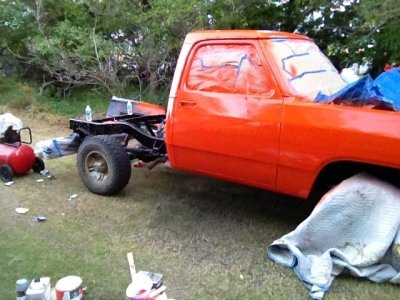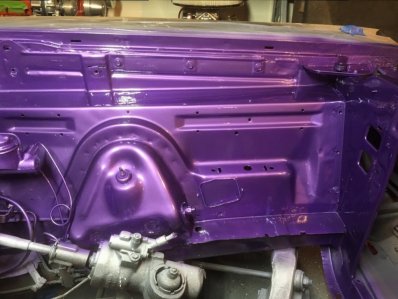drobertson
Well-Known Member
I am beginning the official restoration of my 1973 Charger. I plan on having the car painted plum crazy fc7 purple, with a white vinyl top, etc. The car is mostly rust free, the floor pans are solid, frame rails are solid, trunk floor is solid (minus a small rust hole about the size of a dime). The only rust areas of major concern are the doors.
What's wrong with the doors: the glass was shot out several years ago by some hunters that thought it would be funny to shoot the car (sitting in a field) after getting permission to hunt on the owner's land. Nevertheless, they aren't allowed to ever come back. Over several winters, snow and water collected inside the doors allowing some rust to occur. The floor pans are miraculously perfect though… Long story short, I'm gonna have to find some replacement doors.
The left rear quarter panel is full of bondo, so I'm either gonna pull out the big a$$ dent or just replace the quarter. Advice on that would be great.
For the front fenders, they're all screwed up from "wildlife collisions". It'll be easier to find some new ones, or save some weight and buy some fiberglass fenders. What would you do? Fiberglass? Or buy some old fenders and/or a parts car? The only issue is that I live in northern wyoming…. and these cars are scarce. Will 71-72 front fenders bolt up? I can get some of those easily.
For the hood I'll just use a fiberglass power-bulge hood for weight savings, etc. I also want a fiberglass front bumper, (can a fiberglass front bumper be chromed?)
Once I have the body all straightened out, I'll do what ever small filler work is necessary, and prime it.
Currently, I'm living in an old barn built in 1897. I am NOT going to spray primer OR paint inside of it… but can I at least prime the car outside in the open? Wyoming has almost no humidity, and I feel like it wouldn't be too hard. However I'm not sure if I'd want to paint the car outside, although I have seen incredible paint jobs in which the owner claims it was painted outdoors…
The bottom of my barn is set up like a garage though, and the car will be spending most of it's time in there. I just can't spray primer or paint inside of it. The barn is way too dusty for that anyways… pics coming if y'all want some!
What are the stages of primer and paint? What primer should I use on bare metal? Do I need to use different kinds of primer? Is the summit racing brand primer any good? https://www.summitracing.com/search...er=Ascending&autoview=SKU&keyword=primer&ar=1
What color primer would look best under the plum crazy purple paint? Black, grey, or white? Thanks.
Oh, and are the summit brand paints any good? And what guns would you recommend? Thanks! Sorry for the huge bundle of questions.
What's wrong with the doors: the glass was shot out several years ago by some hunters that thought it would be funny to shoot the car (sitting in a field) after getting permission to hunt on the owner's land. Nevertheless, they aren't allowed to ever come back. Over several winters, snow and water collected inside the doors allowing some rust to occur. The floor pans are miraculously perfect though… Long story short, I'm gonna have to find some replacement doors.
The left rear quarter panel is full of bondo, so I'm either gonna pull out the big a$$ dent or just replace the quarter. Advice on that would be great.
For the front fenders, they're all screwed up from "wildlife collisions". It'll be easier to find some new ones, or save some weight and buy some fiberglass fenders. What would you do? Fiberglass? Or buy some old fenders and/or a parts car? The only issue is that I live in northern wyoming…. and these cars are scarce. Will 71-72 front fenders bolt up? I can get some of those easily.
For the hood I'll just use a fiberglass power-bulge hood for weight savings, etc. I also want a fiberglass front bumper, (can a fiberglass front bumper be chromed?)
Once I have the body all straightened out, I'll do what ever small filler work is necessary, and prime it.
Currently, I'm living in an old barn built in 1897. I am NOT going to spray primer OR paint inside of it… but can I at least prime the car outside in the open? Wyoming has almost no humidity, and I feel like it wouldn't be too hard. However I'm not sure if I'd want to paint the car outside, although I have seen incredible paint jobs in which the owner claims it was painted outdoors…
The bottom of my barn is set up like a garage though, and the car will be spending most of it's time in there. I just can't spray primer or paint inside of it. The barn is way too dusty for that anyways… pics coming if y'all want some!
What are the stages of primer and paint? What primer should I use on bare metal? Do I need to use different kinds of primer? Is the summit racing brand primer any good? https://www.summitracing.com/search...er=Ascending&autoview=SKU&keyword=primer&ar=1
What color primer would look best under the plum crazy purple paint? Black, grey, or white? Thanks.
Oh, and are the summit brand paints any good? And what guns would you recommend? Thanks! Sorry for the huge bundle of questions.

















